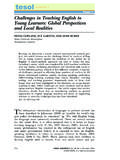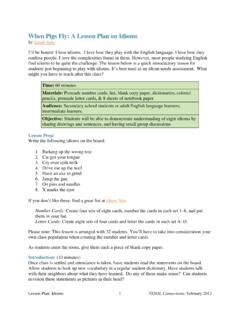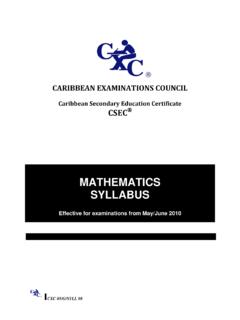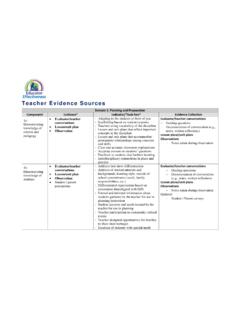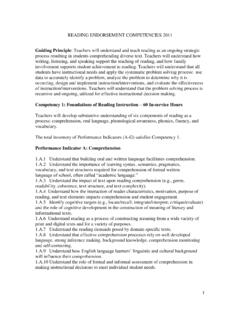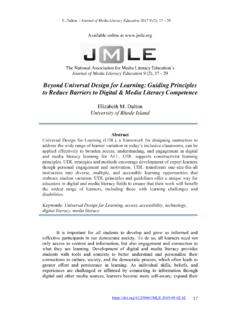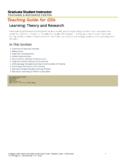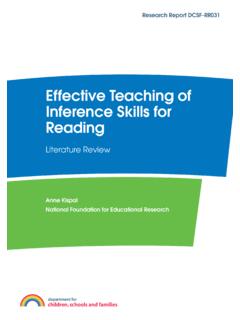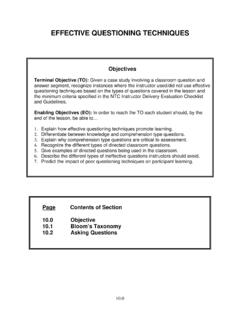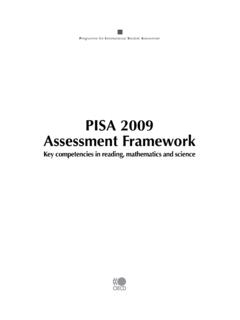Transcription of Reading and Writing Academic Texts
1 144 Reading and Writing Academic TextsIn this chapter, we describe how Academic Reading and Writing are interconnected processes. Smart readers can become smart writers, and if students have a clear sense of their ideas, their Writing is likely to be clear as well. Nonetheless, instructors should remember that individual dif-ferences may affect how students learn to read and write Academic English. For instance, students within one class may have varying linguistic skills and vocabulary knowledge. They may also have little or extensive experience with Academic language either in English or their first language.
2 In addition, students may bring varying cultural expectations and attitudes toward Reading and Writing , which might be influenced by their families or society. They may also have different motivations for Reading and Writing and use a wide range of strategies to approach the Reading task based on their first language literacy skills (Birch, 2007); as Nergis (2013) has shown, students awareness of their own Reading strategies may help them better understand the Texts they read. All of these factors can play a large role in how students approach Reading and and Writing Academic TextsReflective BReakThink about how you learned to read and write in Academic language.
3 Were those two skills taught together or separately? How does your Reading and Writing in Academic settings differ from your Reading and Writing in other contexts? Academic Reading Reading is a complex process that is crucial for students success. Knowing about students Reading experiences early on can help teach-ers tailor their instruction to students needs. For instance, an open-ended survey can provide critical insight into students experiences and attitudes toward Reading . After completing the survey, students can interview each other and ask questions such as: How much read-ing (in English) do you do per week?
4 What is the Reading culture of your country? Of your family? A class discussion can help highlight simi-larities and differences in students experiences and in their prior Academic important piece of information that teachers will want to gather from students concerns their Reading strategies, because Academic Reading differs from other kinds of Reading . Astute readers understand their own Reading strategies so they can adjust them when they encounter any difficulties while Reading . Helping students become aware of their Reading strategies can provide enormous benefits and help them read Academic Texts successfully in their other how can we develop savvy Academic readers?
5 First, we can directly teach effective Reading strategies to students and discuss what successful readers do, which may involve modeling tools and approaches to Reading . Second, we can help students become aware of the strategies they already use. Students could read a short passage, keep track of their thoughts as they read, and answer the following questions: How did I prepare to read? What did I do when I got stuck? Stu-dents can then share their answers with the class as the teacher creates a large list on the board, and then collectively analyze English for Academic PurposesReflective BReakDo you have different strategies for Academic Reading than you do for other kinds of Reading ?
6 In other words, how would you read an Academic text differently than a novel or a magazine article? Before ReadingWhen preparing to teach Reading at any level, it is helpful to think of dividing activities into three main actions. The first step is prepar-ing students for Reading before they read. Just as athletes stretch and warm up their muscles before a race, students should also stretch their mental muscles so they are ready to read and understand the purpose for Reading the particular text. Teachers can help students prepare for Reading by ensuring that they have the vocabulary they need for the text and are familiar with the topic.
7 Teachers can also show students how to look over the Texts quickly, or skim, to gain a sense of how long the text is and how it is organized. Skimming can also help students reflect on what they know already about the topic and help them make predictions about what the text will be about. Overall, prereading activities can engage students in the topic and help them feel confident about the Reading ReadingA second important step is providing structure during the Reading process to ensure that students stay on track and read for the right purposes. A common way to help students focus on a text s purpose is to create a graphic organizer, or the reader s picture of the writer s words (Flemming, 2008, p.)
8 399). Graphic organizers are commonly used to help students make sense of the Texts they read, keep them engaged in Reading , and help them remember what they read. They can also help students understand the text and develop original opin-ions about an idea or ideas in the text. Jiang and Grabe (2007) synthe-size important research findings on graphic organizers and provide several examples of ones that can be used for numerous types of writ-ten Texts . 17 Reading and Writing Academic TextsTable 2. Sample Graphic Organizer for Academic ReadingTEXTWhat kind of text is it?
9 ( , news article, lab report)Who is the text written for?Why did the author write it? What is the main topic of the text?How is the text struc-tured? Which informa-tion comes first? Which details or informa-tion sup-ports this topic? Are there any graphs or tables?Table 2 illustrates a graphic organizer used to support students Reading of source-based Texts . You can adapt this chart to help students examine short Texts ( , a paragraph or a news article) or evaluate lon-ger Texts that include many sources ( , research reports or Academic essays). The main point is that students learn to read for a purpose: to learn new information, determine the author s viewpoint, and process new ideas.
10 Students can also see that Academic Writing has a clear pur-pose and audience, which reinforces Writing instruction. After ReadingFinally, students should cool down after Reading and assess what they have learned. Questions that focus on students comprehension are typical; however, there are additional ways that students can expand on what they have read. At this stage, they can summarize the text or criti-cally respond to it by evaluating an author s argument, extending an author s idea to their lives, applying the main idea to another context, or discussing their opinion of the text.
